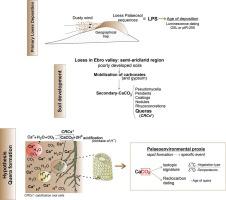Our official English website, www.x-mol.net, welcomes your feedback! (Note: you will need to create a separate account there.)
Biogenic carbonates (queras) in loess-palaeosol sequences of the Ebro Basin and their potential use as a palaeoenvironmental proxy
Catena ( IF 6.2 ) Pub Date : 2024-03-15 , DOI: 10.1016/j.catena.2024.107969 Daniela Álvarez , Carlos Alberto Torres-Guerrero , Anna Travé , Frank Preusser , José M. Plata , Rosa M. Poch
Catena ( IF 6.2 ) Pub Date : 2024-03-15 , DOI: 10.1016/j.catena.2024.107969 Daniela Álvarez , Carlos Alberto Torres-Guerrero , Anna Travé , Frank Preusser , José M. Plata , Rosa M. Poch

|
Secondary carbonate accumulations are very common in arid and semi-arid soils but are often poorly described and classified. This is the case for queras that are observed in several loess-palaeosol sequences of the Ebro Basin. Micromorphologically, queras are complex pedogenic features basically consisting of infillings of calcified root cells in channels, surrounded by decarbonated hypocoatings. They apparently result from biologically mediated calcification/decalcification processes at a microscale. The aim of this study is to systematically characterize biocalcifications found in dated loess-palaeosol sequences, to determine the main factors of formation, and to discuss their possible use as a palaeoenvironmental proxy. Different queras show a similar number of biosparite layers (four to five) around a central channel, and a decarbonated hypocoating around the queras. This supports the hypothesis that queras originate from the calcification of root tips and are related to the acidification of surrounding soil for nutrient absorption. Under cathodoluminescence microscopy, biosparite has a different behaviour than non-biological calcite crystals: the latter appears reddish while biosparite remains black. The queras, with ages corresponding to Marine Isotope Stages 1–3, are younger than that of the loess where they are found in. The stable isotope values likely correspond to C3 plants, and the estimated temperatures of formation reflect a Mediterranean temperate climate. This suggests that the biocalcifications developed during short moist seasons amidst arid periods of the Quaternary.
中文翻译:

埃布罗盆地黄土-古土壤序列中的生物碳酸盐(queras)及其作为古环境替代物的潜在用途
次生碳酸盐积累在干旱和半干旱土壤中非常常见,但通常很少被描述和分类。在埃布罗盆地的几个黄土-古土壤序列中观察到的奎拉就是这种情况。从微观形态上看,queras 是复杂的成土特征,基本上由通道中钙化根细胞的填充物组成,周围有脱碳的低涂层。它们显然是微尺度生物介导的钙化/脱钙过程的结果。本研究的目的是系统地描述已定年黄土-古土壤序列中发现的生物钙化特征,确定形成的主要因素,并讨论它们作为古环境替代物的可能用途。不同的奎拉斯在中央通道周围显示出相似数量的生物星石层(四到五层),并且在奎拉斯周围有脱碳的低涂层。这支持了这样的假设:奎拉斯起源于根尖的钙化,并与周围土壤酸化以吸收养分有关。在阴极发光显微镜下,生物星云石与非生物方解石晶体具有不同的行为:后者呈微红色,而生物星云石则保持黑色。奎拉斯的年龄对应于海洋同位素阶段 1-3,比它们所在的黄土年龄要年轻。稳定同位素值可能对应于 C3 植物,估计的形成温度反映了地中海温带气候。这表明生物钙化是在第四纪干旱时期短暂的潮湿季节中形成的。
更新日期:2024-03-15
中文翻译:

埃布罗盆地黄土-古土壤序列中的生物碳酸盐(queras)及其作为古环境替代物的潜在用途
次生碳酸盐积累在干旱和半干旱土壤中非常常见,但通常很少被描述和分类。在埃布罗盆地的几个黄土-古土壤序列中观察到的奎拉就是这种情况。从微观形态上看,queras 是复杂的成土特征,基本上由通道中钙化根细胞的填充物组成,周围有脱碳的低涂层。它们显然是微尺度生物介导的钙化/脱钙过程的结果。本研究的目的是系统地描述已定年黄土-古土壤序列中发现的生物钙化特征,确定形成的主要因素,并讨论它们作为古环境替代物的可能用途。不同的奎拉斯在中央通道周围显示出相似数量的生物星石层(四到五层),并且在奎拉斯周围有脱碳的低涂层。这支持了这样的假设:奎拉斯起源于根尖的钙化,并与周围土壤酸化以吸收养分有关。在阴极发光显微镜下,生物星云石与非生物方解石晶体具有不同的行为:后者呈微红色,而生物星云石则保持黑色。奎拉斯的年龄对应于海洋同位素阶段 1-3,比它们所在的黄土年龄要年轻。稳定同位素值可能对应于 C3 植物,估计的形成温度反映了地中海温带气候。这表明生物钙化是在第四纪干旱时期短暂的潮湿季节中形成的。



























 京公网安备 11010802027423号
京公网安备 11010802027423号